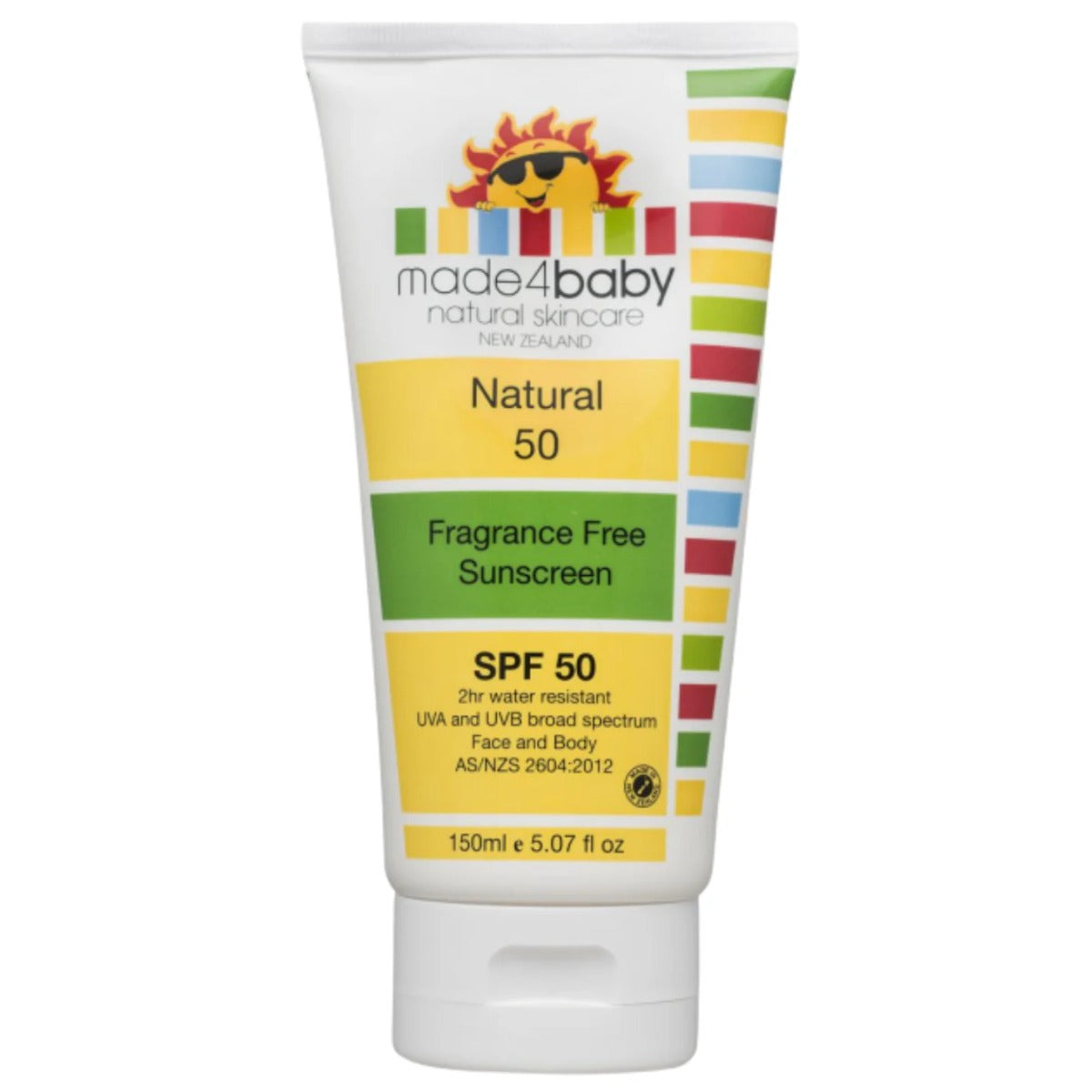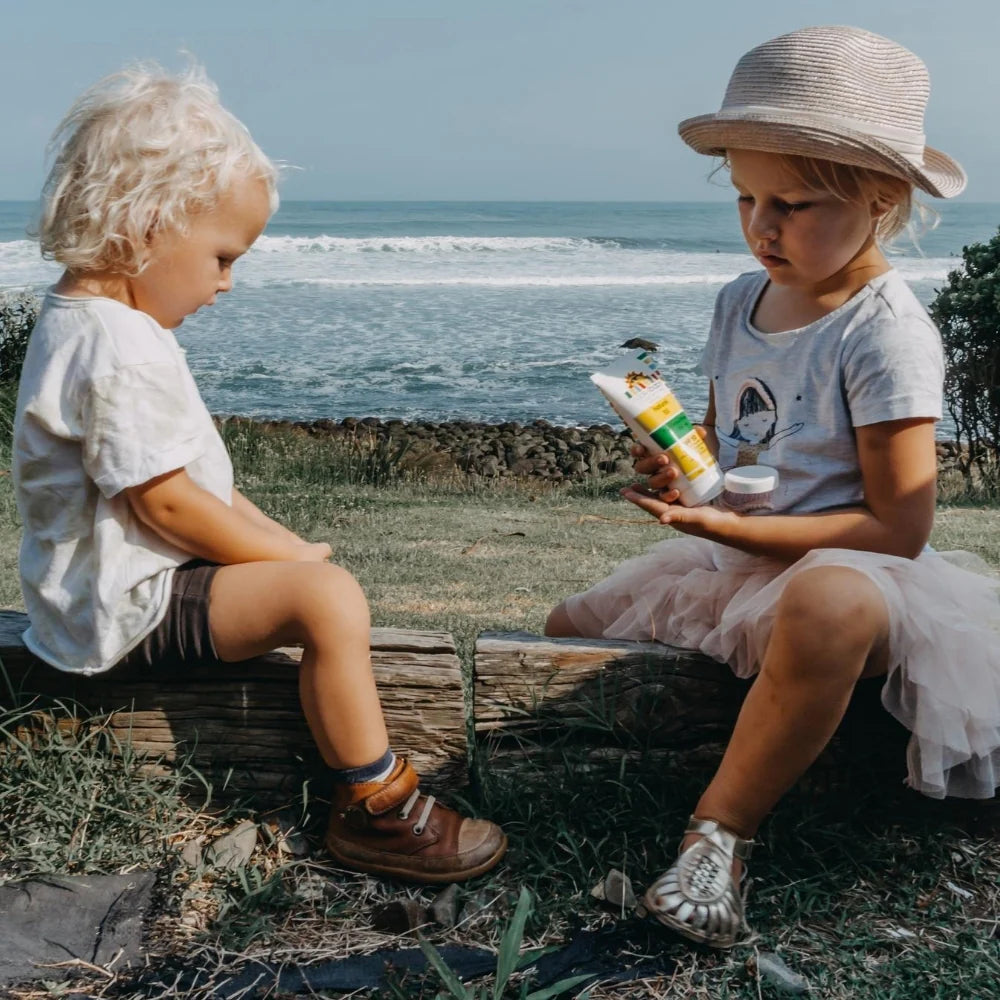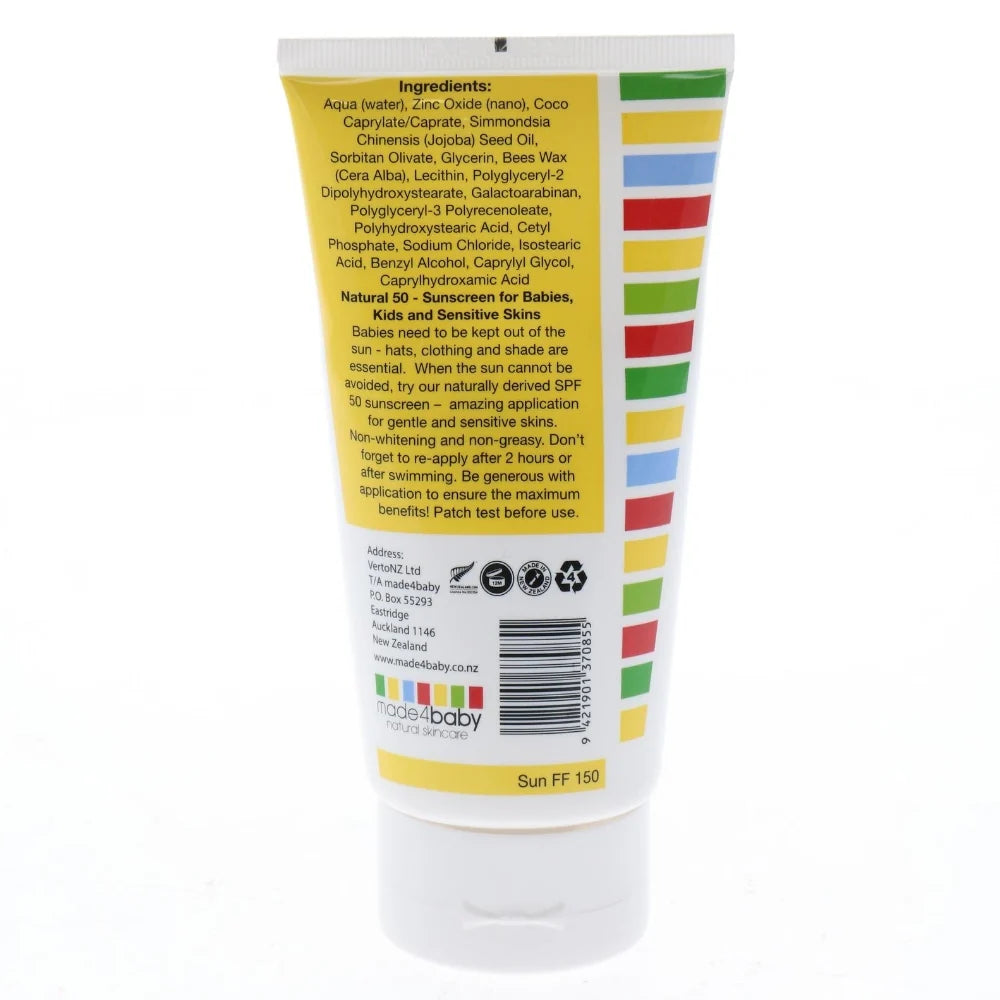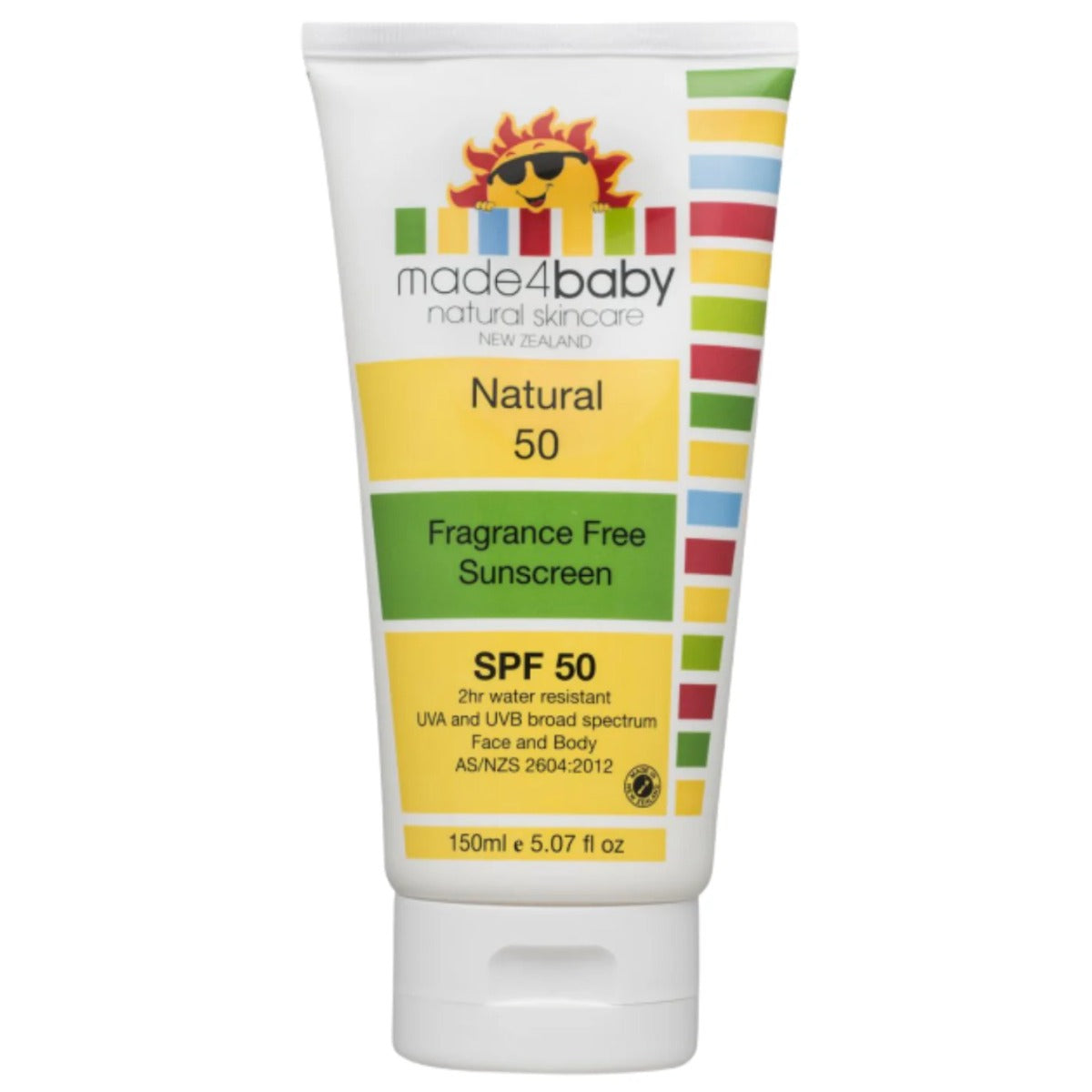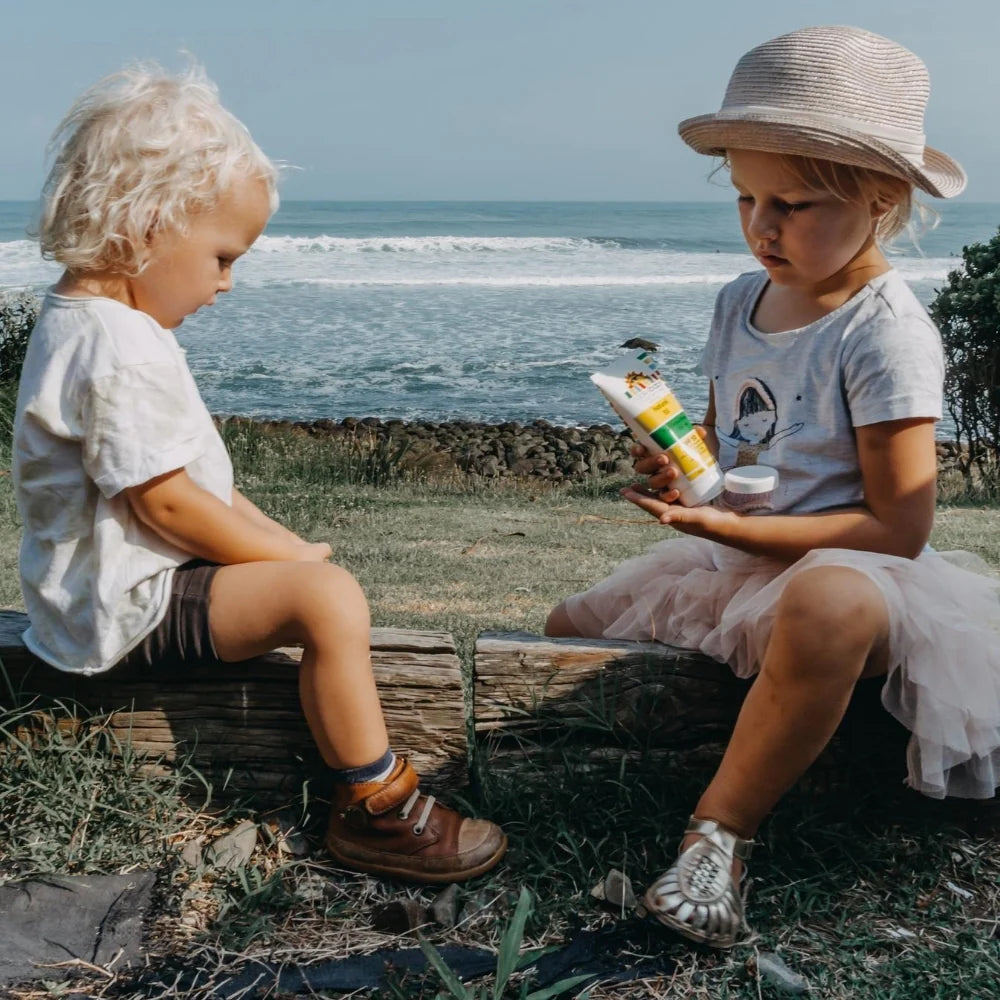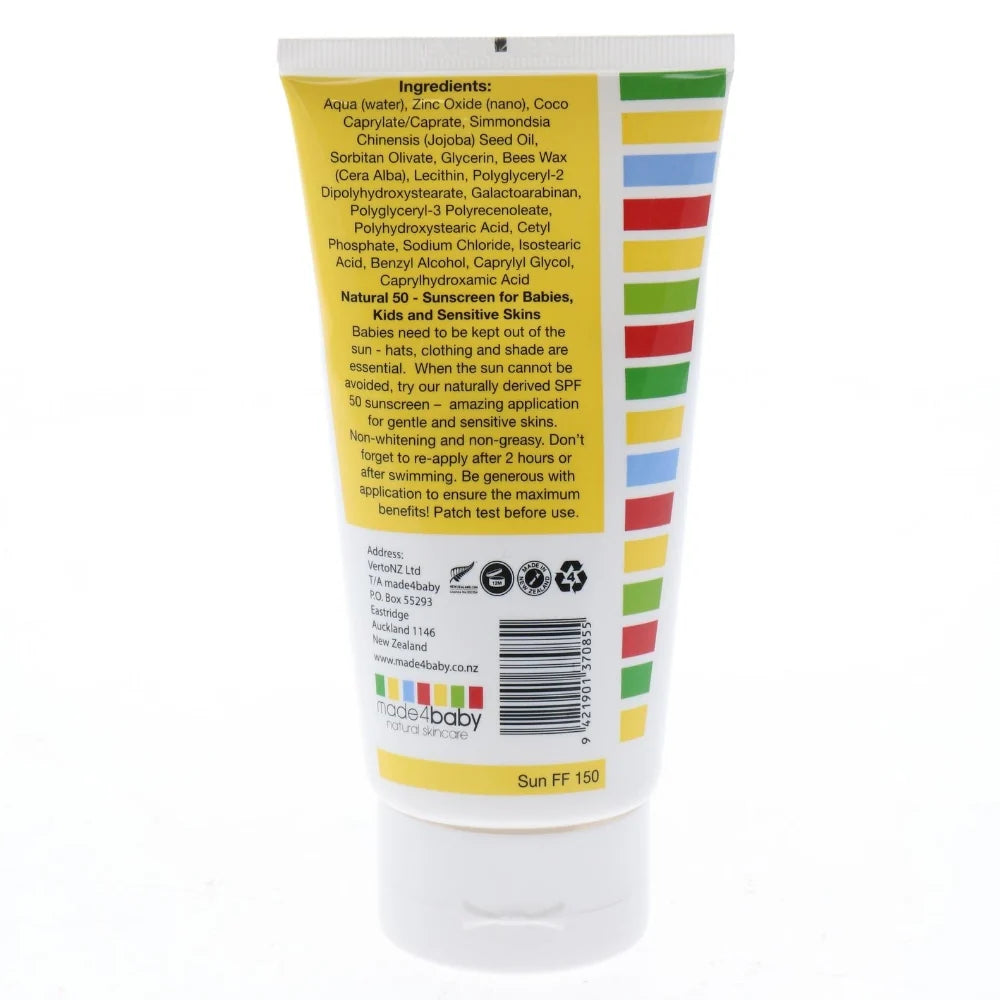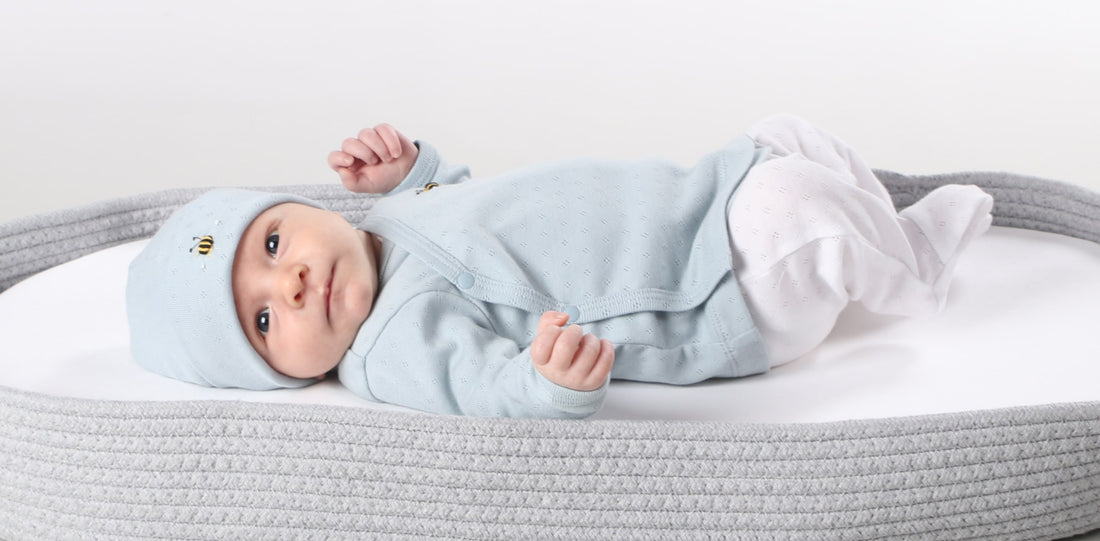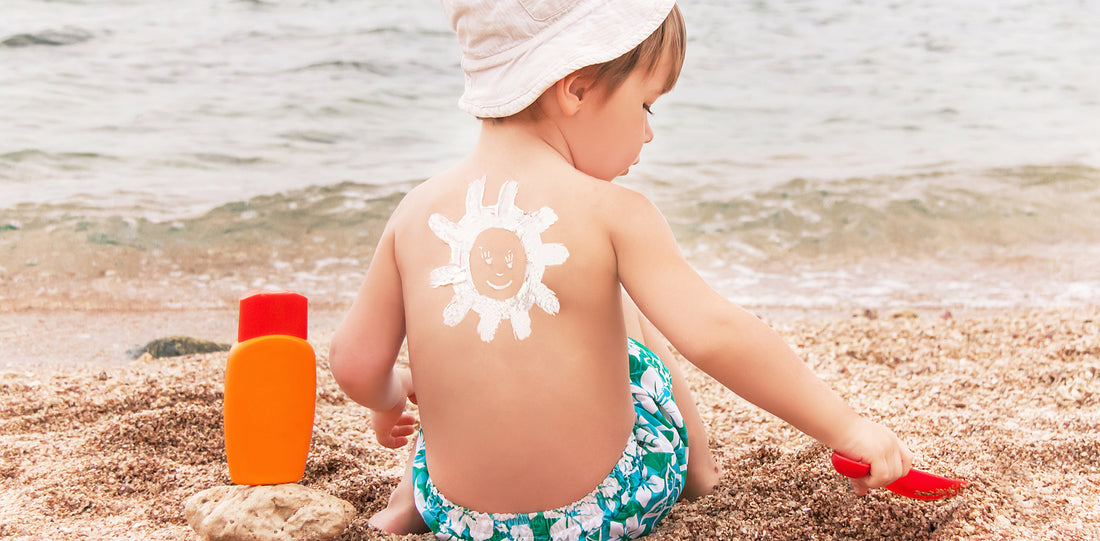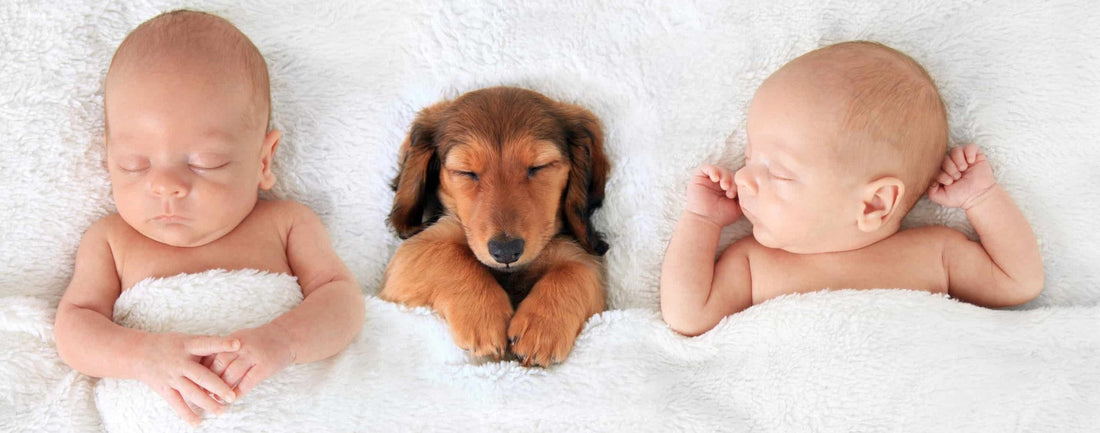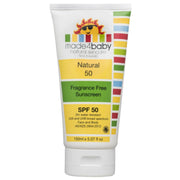Made 4 Baby Natural Sunscreen - 150ml
Made 4 Baby Natural Sunscreen - 150ml
SKU:SUNFF150
Clothing Prem to 18 Months
| Size | Age Guide | Weight | Height |
|---|---|---|---|
| Premature | Premature or Small Newborn | Up to 4Kg | Up to 55cm |
| Newborn | 0-3 months | 4-6Kg | Up to 62cm |
| 3 Month | 3-6 months | 6-8Kg | Up to 68cm |
| 6 Month | 6-12 Month | 8-10Kg | Up to 76cm |
| 12 Month | 12-18 Month | 10-12Kg | Up to 84cm |
| 18 Month | 18-24 Month | 12-14Kg | Up to 92cm |
Clothing 2 to 6 Years
| Size | Age Guide | Height | Chest | Waist | Hip |
|---|---|---|---|---|---|
| 2 Year | 2-3 Years | Up to 100 cm | 56 | 51 | 58 |
| 3 Year | 3-4 Years | Up to 105 cm | 58 | 53 | 60 |
| 4 Year | 4-5 Years | Up to 110 cm | 60 | 55 | 62 |
| 5 Year | 5-6 Years | Up to 115 cm | 62 | 57 | 64 |
| 6 Year | 6-7 Years | Up to 120 cm | 64 | 59 | 66 |
Beanie Size Guide
| Size | Head Circumference | Age Guide |
|---|---|---|
| Premature | 31-35 cm | Premature or Small Newborn |
| Newborn | 35-40 cm | Newborn |
| Small | 40-43 cm | 3-6 Months |
| Medium | 43-47 cm | 6-18 Months |
| Large | 47-52 cm | 18-3 Years |
Sunhat Size Guide
| Size | Head Circumference | Age Guide |
|---|---|---|
| Newborn | 37-40 cm | Newborn |
| Small | 40-43 cm | 3-6 Months |
| Medium | 43-46 cm | 6-12 Months |
| Large | 46-49 cm | 12-24 Months |
| Xtra Large | 49-54 cm | 2-4 Years |
Sleep Pods Size Guide
| Size | Weight | Age Guide | Measurement(Back to Hem) |
|---|---|---|---|
| Newborn | 0-6 kgs | 0-3 Months | 60.5 cm |
| Small | 0-8 kgs | 3-6 Months | 66 cm |
Booties Size Guide
| Size | Age Guide |
|---|---|
| Newborn | 0-3 Months |
| Small | 3-6 Months |
| Medium | 6-12 Months |
| Large | 12-18 Months |
Pretty Brave Baby
| Foot Length (mm) | Insole Length (mm) | EU | UK | Age | INT |
|---|---|---|---|---|---|
| 95-104 | 110 | 16/17 | 2 | 0-6m | S |
| 104-114 | 118 | 18 | 3 | 6-12m | M |
| 114-123 | 127 | 19/20 | 4.5 | 12-18m | L |
| 123-137 | 142 | 21/22 | 5.5 | 16-22m | XL |
Pretty Brave 1st Walker
| Foot Length (mm) | Insole Length (mm) | EU | UK | Age |
|---|---|---|---|---|
| 114-120 | 125-128 | 19 | 3 | 1 yr |
| 120-126 | 132-135 | 20 | 3.5 | 1-2 yrs |
| 126-132 | 138.5-141.5 | 21 | 4.5 | 1-2 yrs |
| 132-138 | 145-148.5 | 22 | 5 | 2 yrs |
Crywolf Swim Nappy
| Size | Length (waist to crotch) | Crotch Width (side to side) |
|---|---|---|
| 0-1 yr | 1-2 yrs | |
| 37 | 38 | |
| 14.5 | 15.5 |
Crywolf Rash Suit
| Size | Length (back neck to crotch) | Chest (arm to arm) | Waist (side to side) | Sleeve (neck to cuff) | Neck Opening(diameter) |
|---|---|---|---|---|---|
| 6-12 Months | 1 yr | 2 yrs | 3 yrs | ||
| 40 | 42 | 44 | 46 | ||
| 25 | 26 | 27 | 28 | ||
| 24 | 25 | 26 | 27 | ||
| 30 | 31.5 | 33 | 34.5 | ||
| 13.25 | 13.25 | 13.8 | 14.3 |
In stock
Couldn't load pickup availability
Overview
Overview
Made4Baby's Natural Sunscreen SPF 50 is your family’s go-to for safe, powerful sun protection without harsh chemicals. Crafted in New Zealand, this fragrance-free formula offers SPF 50 broad-spectrum protection against UVA and UVB rays, keeping skin shielded under even the strongest sun. Ideal for outdoor adventures, it's water-resistant for up to two hours, allowing little ones to play without worry.
With its light, non-greasy texture, this sunscreen glides on easily, leaving a gentle finish that’s suitable for both face and body. Plus, it’s coral reef friendly, containing no oxybenzone or octinoxate, so you can feel good about protecting both your family’s skin and the ocean. Made4Baby ensures quality and safety for every sunny day.
What's Included
What's Included
Technical Specification
Technical Specification
Delivery and Returns
Delivery and Returns
- Delivery: Free within NZ on orders over $100 (excluding bulky items) or $8 standard shipping
- Returns: Accepted within 14 days of receipt with proof of purchase
- Some items are excluded from returns including sale items, hardware, car seats, prams, monitors and personal items - please click here for the full list.
Share this product
Recently Viewed Products
Related Blogs
Natural Clothing and Allergies
The best clothing choices for allergies Soft, natural, gentle Babies’ skin is soft, gorgeous – and sensitive. When they’re young, their skin is much thinner and more permeable than that of an adult, which is why it’s so susceptible to irritation and dryness. Although all babies have delicate skin, some have more serious skin conditions like eczema, hives, and other irritations. These increasingly common conditions can be caused or exacerbated by food allergies, and environmental triggers like laundry powders, soaps, and clothing. While the right clothing can’t cure eczema or allergies, it can help reduce the symptoms and make your baby more comfortable. Soft, natural fibres, organic fabrics, chemical-free processing and quality craftsmanship can help. Here’s what to look for: Naturally gentle Eczema-prone skin is irritated by harsh fibres and heat. Synthetic fabrics and thick weaves – like denim or hand-knitted wool – can trap heat, rub against the skin, and make symptoms worse. Look for clothing made of soft, naturally breathable fabric like cotton, linen, and hemp. Although thick wool can be irritating, finely woven merino clothing is gentle enough for most eczema-prone babies. In fact, because merino helps wick away moisture and regulate temperature, it can actually help reduce skin irritation caused by overheating. Choose organic Because babies’ skin is so permeable, it can absorb harsh chemicals from clothing. That’s why it’s important to choose organic fabrics as much as possible. Conventional cotton crops are treated with a range of pesticides, fungicides, and herbicides while they’re growing. No matter how much you wash clothing before wear, traces of these chemicals can remain in the fibres and transfer to your baby’s skin, potentially causing allergic reactions or general irritation. Avoid the issue by choosing pure, certified organic cotton as much as you can. Soft colours for soft skin During processing, cotton and other fabrics may be bleached, dyed, and treated with chemicals like softeners, fire retardants, and wrinkle or stain guards. These chemicals are designed to stay in the fibres of the fabric, which means they end up pressed against your baby’s skin, potentially triggering eczema flare-ups or irritation. Often, high-quality organic cotton and merino products are made without these chemicals to avoid these issues, and some manufacturers will list clothing as allergy-friendly or chemical-free. If you’re unsure, choosing white or undyed organic cotton or merino is the best option. Made with care Good craftsmanship is just as important as quality materials. Cheaply made baby and children’s clothing is often ill-fitting, with rough seams and scratchy labels – all highly irritating to sensitive skin. Quality clothing, on the other hand, is designed to fit comfortably. Look for clothing without tight sleeves, elastic at the cuffs, or high necklines – these can all chafe and irritate sensitive skin. Seams should be sewn flat and labels should be printed on the fabric or easy to remove. Go natural for extra care Whether your baby has allergies or not, you can’t go wrong choosing gentle, natural, soft clothing. You’ll keep them warm and comfortable, avoid harsh chemicals, protect their skin, and reduce the risk of irritation. At Dimples, all our baby clothes are made of natural fibres, with quality craftsmanship, comfortable, classic designs and minimal chemicals used in processing. Take a look now.
Learn moreSummer smart, right from the start
Keeping little ones safe this summer After a long, cold, virus-heavy winter, many parents will be looking forward to summer – warmer days, fewer illnesses, and time outside with the kids. But after last year’s record-high temperatures, it’s important to remember that summer has dangers too. Babies, with their delicate skin and inability to regulate temperature, are particularly sensitive to harsh sun and heat. Make sure you’re aware and prepared before summer starts, so you can protect your wee ones – no matter how hot it gets. Here’s our summer safety toolkit: Safer with sunscreen Babies and small children have delicate skin that burns easily, so sunscreen is a non-negotiable in the summer months. Even if your children hate the application process, it’s still something that has to be done. If you make it a regular part of their morning routine, they’ll get used to it eventually. • Choose a broad-spectrum sunscreen with SPF30+ at minimum. • Apply sunscreen at least 15 minutes before you go outside, and remember to reapply every 3-4 hours. • Use plenty – apply sunscreen thickly, and don’t miss areas like the back of the arms or ears. • Keep bottles of sunscreen everywhere – the car, the baby bag, grandparents’ house – so you’re never caught without it. • Don’t forget sunscreen on cloudy days – 80% of rays penetrate through cloud cover, so you can still get burnt. Buy the Made 4 Baby SPF50 Natural Sunscreen HERE . Shade solutions Sunscreen is a must if you’re out in the sunshine, but it’s not the only way to prevent sunburn or overheating. Staying indoors or in the shade during the hottest part of the day helps you avoid the heat altogether while dressing appropriately keeps you – and your children – safe and comfortable. • Try to avoid the sun between 11am-4pm, when UV rays are strongest. • Dress your children in loose, dark-coloured or UV-protective clothing and swimwear – the sun’s rays can penetrate light, thin fabrics. • Choose long-sleeved swimwear. • Make sure your babies and children always wear hats – full brim is best. • Use a sunshade or cover for your pram – but make sure it’s not preventing airflow to your baby, or she could overheat. • Use a shade cloth or stick-on shade in the car, to keep your baby’s seat out of the sun. Check out our range of Cotton Products Here Overheating and hydration During the summer months, it’s important to keep babies and children hydrated and cool as much as possible. Because they’re less developed than adults, babies and small children can’t regulate their body temperature properly, which means they’re more susceptible to overheating. During record high temperatures, overheating and dehydration can be a real concern for smaller babies. Although it’s less common in New Zealand’s fairly temperate climate, babies have died of heat exhaustion in extreme weather • Keep small children indoors, preferably with air conditioning on, during very high temperatures. • Make sure children drink plenty of fluids – homemade ice-blocks are a great way to get more liquid into them. • Give breastfed babies more frequent feeds – your milk will naturally be less concentrated to keep your baby hydrated. Drink more water yourself. • Bottle-fed babies should also be given more feeds – you can offer small amounts of water if you’re concerned about dehydration. • Dress babies and children lightly for sleep, and use a fan or air conditioning to keep the temperature in their room down. • Never leave a baby or child alone in the car, as temperatures can rise extremely rapidly. • If your baby or child is showing signs of dehydration or heatstroke – including lethargy, a dry mouth, fewer wet nappies, or a sunken fontanelle – seek medical treatment immediately. If it all sounds a bit alarming, don’t worry. Summer should be a time of fun and relaxation, even when you do have small children. As long as you’re aware and well prepared, you – and your wee ones – should be fine. Don't Forget the Sunscreen! Buy Sun Lotion Here
Learn morePostnatal Pelvic Floor Health: A Physiotherapist’s Guide
Bringing a new baby into the world is an incredible journey, but one that places big demands on your body - especially your pelvic floor.
Learn moreWhen Pets Meet Babies
Welcoming Your Baby and Fur Baby Together 🐾👶 For many families, pets are our first “babies” – loyal companions who’ve shared the couch, the bed, and plenty of milestones. So when a new human baby comes along, it’s natural to worry about how everyone will adjust. The good news? With a bit of preparation and kindness, your pet and baby can build a beautiful bond from the very beginning. Start with Your Pet’s Personality 🐶🐱 Every animal is different, and how you prepare depends on your pet’s species, temperament, and past experiences. While goldfish or guinea pigs usually require little adjustment, cats and dogs can be more sensitive to the changes a baby brings – new sounds, smells, routines, and less attention. If your pet hasn’t spent much time around children, consider slowly exposing them to baby-related sounds (like crying or giggling) using recordings beforehand. This can help desensitise them and reduce anxiety once baby is home. A Gentle Introduction is Key Before baby arrives, introduce your pet to baby items like the pram, cot, or bassinet. Let them explore at their own pace so these new additions don’t feel overwhelming later. You can even go for practice walks with the pram to help your dog get used to the change. When baby comes home, offer your pet something with baby’s scent – like a swaddle or hat – before the first face-to-face meeting. For dogs, initial introductions should be calm and ideally on leash, in a neutral space like the front yard. For cats, allow them to approach in their own time and retreat when they’ve had enough. Reward your pet for calm, gentle behaviour with treats or praise to create positive associations with baby. Safety First – Always 💛 No matter how friendly or socialised your pet is, never leave them alone with your baby. Even well-meaning pets can act unpredictably when startled or stressed. Cats may try to jump into the bassinet to cuddle up, which can be dangerous. Consider using a cat net over the cot or keeping the nursery door closed. For dogs, teach them to respect baby’s space and avoid licking or nudging the baby. Once your baby becomes mobile, always supervise interactions and start gently teaching respectful handling – this not only keeps everyone safe but helps your child grow up with empathy and confidence around animals. Create Safe Spaces for Everyone As your household routine shifts, pets will appreciate having a quiet, baby-free zone to retreat to. Use pet gates or closed doors to keep their food, bedding, and litter trays separate. This not only protects your pet’s resources but keeps curious toddlers away from things they shouldn’t be touching (or tasting!). Make sure escape routes like cat doors are secure, and create high perches or quiet corners where your cat can safely observe without feeling overwhelmed. Managing Allergies and Cleanliness Pet hair is a common allergen, and while it’s impossible to know if your baby is sensitive right away, there are a few preventative steps you can take: Vacuum regularly (a pet-specific vacuum can help). Bathe or groom your pet as advised by your vet. Keep pets off nursery furniture and out of the baby’s sleeping space. Consider using an air purifier in high-traffic areas. It’s also a good idea to wash baby’s hands after contact with your pet – especially once they start crawling! Don’t Forget About Your Pet’s Routine ❤️ Newborns take up a lot of time and energy – and pets can sometimes feel left out. Sticking to familiar routines, like walks, feeding times, and play, helps them feel secure. Enlist friends or family to help out with dog walking or play sessions, especially in those early weeks. Cats benefit from mental stimulation too – puzzle feeders or interactive toys can be great for independent play. Some parents also find that having their pet involved in small baby routines (like sitting nearby during nappy changes or walks in the pram) can help strengthen the bond early on. Growing Together: A Bond Like No Other With time, patience, and gentle consistency, your baby and fur baby will adapt to each other – and may even become inseparable friends. Watching them grow up side by side is one of life’s simple joys 🥰 If you’re getting ready to welcome a baby into your home and have questions about creating a calm, safe space for both little ones and furry friends, don’t hesitate to get in touch with the team or pop into your local Dimples store – we’re always happy to help.
Learn more

